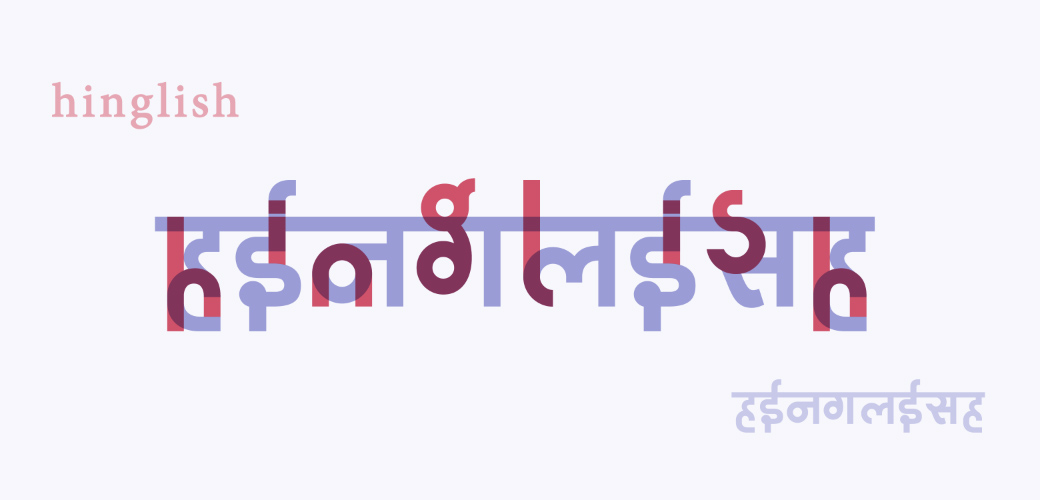FORGET HINDI AND ENGLISH: HINGLISH IS HERE TO STAY IN INDIA
The British have been borrowing Indian words since the earliest days of the British collonization. Some of the most well-known examples have made their way into the English lexicon include guru, yoga and curry.
But you might be surprised to hear that pyjamas, bangle, jodhpurs, look, khaki, bungalow, shampoo and even the term Blighty, used to describe Britain, are all of Indian origin as well. Thug is another word that has made the transition.
The opposite is also happening in India today. The economic boom in the country has not only blurred the boundaries of the caste system, it has given birth to ‘Hinglish’ – a fashionable new language that is used routinely in music, films and advertising copywriting.
If you’re exporting your product or service to India, then Hinglish is something you must seriously consider.
WHAT IS HINGLISH?
Hinglish is one of the world’s most potent Anglo-hybrids – and it is often described as the key to advertising success in India.
The language, which is essentially English with a Hindi take, represents ‘Estuary English’ for the common person of India, the vernacular of the middle-class and the so-called fashionable set through which millions of Indians communicate.
It mixes Hindi and English words together, not to mention sentence structures, to create its very own version of English.
HOW HAS HINGLISH SPREAD?
The mixing between Hindi and English vocabulary has occurred ever since colonial times. Only in the last few years, however, has Hinglish matured and found its place in India as an effective communication tool.
Television channels and radio stations in the country now move freely between the two languages, as do music and movies. This, combined with cheaper televisions and greater access to the internet, means the influence of Hinglish is no longer confined to the bright lights of the cities. It is spreading to rural areas as well.
The impact of Hinglish is therefore finding its way into other areas of everyday Indian life, making it the language of the home, work and business. Just speaking English in India no longer cuts it when it comes to selling products and services – and this is something that advertisers need to make sure they are aware of.
Over the last 200 years, English has always been the language of choice for businesses, private schools and the upper classes in India. It is the lingua franca through which the masses communicate, serving as common ground between the hundreds of regional varieties of Hindi and other languages spoken by the population.
It was consequently only a matter of time before Hinglish was born, much like Chinglish in China and Singlish in Singapore.
WHAT IS THE IMPACT OF HINGLISH ON BUSINESS IN INDIA
Companies without a basic understanding of Hindi words risk missing potential gaps in the Indian market.
For advertising to succeed in modern India, Hinglish has to be the language of choice. It is the language that the Indian customer is most receptive to, particularly the younger generation, so not using it is a massive faux pas.
The young urban youth regards Hinglish as a badge of cool. To this group of people the language is part of their identity.
Simple statements work best in Hinglish. The strategy should be to make sure the message of the advertisement is engrained in the memory of consumers – and tradition dictates that the best way to achieve this is use more Hindi than English.
BREAKING THE MOULD
Pepsi was the forerunner of Hinglish advertising in India. The tagline ‘Yeh hi hai right choice, baby’ meaning ‘You got the right one, baby’ proved to be one of the most successful in the company’s history.
Before the campaign launched in 1990, however, there was a lot of snobbishness regarding the use of Hinglish in Indian society; people looked down on it, viewing it as a poor, almost dumb variety of English.
But Pepsi changed all that. India soon opened its doors to a world of choices and Hinglish gradually took hold.
EXAMPLES OF HINGLISH ADVERTISEMENTS
There are a number of the really popular Hinglish slogans in India. Here we pick out some of the best:
- Hungry Kya (Are you Hungry?) – Domino’s Pizza
- Yeh Dil maange more (The heart wants more) – Pepsi
- Kya aap Close Up karte hain? (Do you use Close-Up toothpaste?) – Close-Up
- Come on girls, waqt hai shine karne ka! (Come on girls, it’s time to shine!) – Sunsilk
- Life ho to aisi (Life should be life this) – Coca Cola
What your bahana is? (What’s your excuse eating McDonalds instead of home-cooking?) – McDonalds.
In fact, the vast majority of multi-nationals in India now use Hinglish – and they are reaping the rewards because of this.
According to the creative head of a major advertising agency in India, the localization approach doesn’t work for the vast majority of Indians whose English is not always great. “You may be understood, but not vibed with,” he says. “That’s why all the multi-national corporations in India now speak Hinglish in their ads.”
WHAT DOES THE FUTURE HOLD?
India is a country still struggling to establish an identity. It is fair to say that Hinglish has a big role to play moving forward.
But what will this role be? Well, judging by how the language is used at present, it will remain a prominent communication tool in the world of business and advertising, not to mention everyday life.
Whether it makes the transition to the classroom remains to be seen. One thing that is for sure, however, is that Hinglish will keep on developing and evolving so long as it remains in the public space.
People are not just mixing Hindi and English words anymore, they are creatively, actively and energetically reinventing them instead. Hinglish therefore looks likely to continue pushing the barriers of advertising in India.
Yusuf Bana is an Indian content writer, copywriter, copy editor working for different communication and transcreation agencies. He’s been active in digital content marketing and web development for many years, across a wide range of industries and clients.




